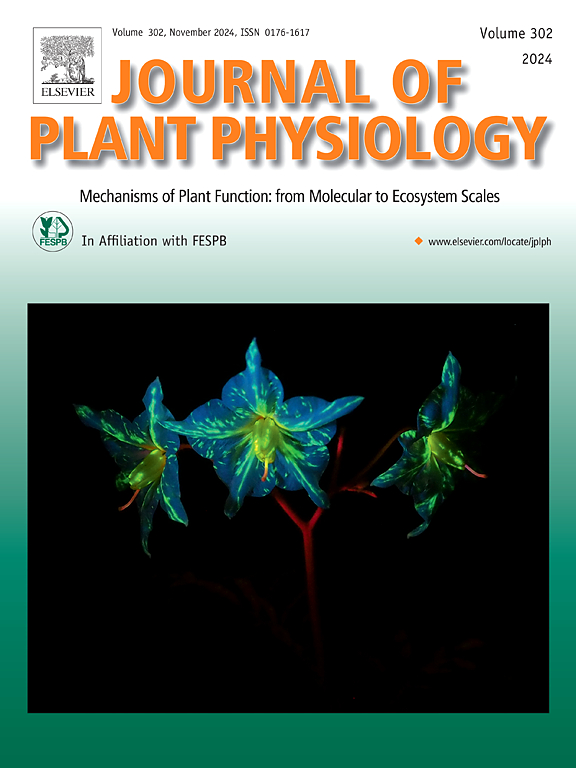FvGCN5的过表达增强了林地草莓对灰霉病的抗性
IF 4.1
3区 生物学
Q1 PLANT SCIENCES
引用次数: 0
摘要
组蛋白乙酰化介导的表观遗传修饰在植物发育和逆境响应中起着重要作用。然而,草莓中组蛋白乙酰转移酶GCN5调控生物胁迫的机制尚不清楚。本研究从林地草莓中分离到FvGCN5,发现FvGCN5可能通过与FvADA2a和FvADA2b相互作用形成保守的SAGA (Spt-Ada-Gcn5乙酰转移酶)复合物。此外,我们发现FvGCN5可以显著诱导真菌病原菌灰葡萄孢(Botrytis cinerea)的感染,并且过表达FvGCN5的转基因草莓植株对灰葡萄孢的抗性增强。进一步基于rna -seq的转录组和定量PCR分析表明,FvGCN5过表达系中FvMYC2和FvPR1等抗病基因显著上调。综上所述,我们的研究表明FvGCN5通过激活抗病基因在林地草莓对灰绿杆菌的抗性中发挥了重要作用。本文章由计算机程序翻译,如有差异,请以英文原文为准。
Overexpression of FvGCN5 enhances the resistance of woodland strawberry against Botrytis cinerea
Epigenetic modifications mediated by histone acetylation play essential roles in plant development and stress response. However, the mechanism of regulating biotic stress through histone acetyltransferase GCN5 in strawberry is still unclear. In this study, we isolated FvGCN5 from woodland strawberry and found that FvGCN5 may form the conserved SAGA (Spt-Ada-Gcn5 acetyltransferase) complex through interaction with FvADA2a and FvADA2b. In addition, we found that FvGCN5 could be significantly induced by the infection of fungal pathogen Botrytis cinerea, and that the transgenic strawberry plants overexpressing FvGCN5 exhibited enhanced resistance against B. cinerea. Further RNA-seq-based transcriptome and quantitative PCR analysis indicated that several disease-resistant genes such as FvMYC2 and, FvPR1 were significantly upregulated in FvGCN5 overexpression lines. Taken together, our study indicates that FvGCN5 plays important roles in the resistance against B. cinerea in woodland strawberry through activating disease-resistant genes.
求助全文
通过发布文献求助,成功后即可免费获取论文全文。
去求助
来源期刊

Journal of plant physiology
生物-植物科学
CiteScore
7.20
自引率
4.70%
发文量
196
审稿时长
32 days
期刊介绍:
The Journal of Plant Physiology is a broad-spectrum journal that welcomes high-quality submissions in all major areas of plant physiology, including plant biochemistry, functional biotechnology, computational and synthetic plant biology, growth and development, photosynthesis and respiration, transport and translocation, plant-microbe interactions, biotic and abiotic stress. Studies are welcome at all levels of integration ranging from molecules and cells to organisms and their environments and are expected to use state-of-the-art methodologies. Pure gene expression studies are not within the focus of our journal. To be considered for publication, papers must significantly contribute to the mechanistic understanding of physiological processes, and not be merely descriptive, or confirmatory of previous results. We encourage the submission of papers that explore the physiology of non-model as well as accepted model species and those that bridge basic and applied research. For instance, studies on agricultural plants that show new physiological mechanisms to improve agricultural efficiency are welcome. Studies performed under uncontrolled situations (e.g. field conditions) not providing mechanistic insight will not be considered for publication.
The Journal of Plant Physiology publishes several types of articles: Original Research Articles, Reviews, Perspectives Articles, and Short Communications. Reviews and Perspectives will be solicited by the Editors; unsolicited reviews are also welcome but only from authors with a strong track record in the field of the review. Original research papers comprise the majority of published contributions.
 求助内容:
求助内容: 应助结果提醒方式:
应助结果提醒方式:


